To fix your driveway like a pro, choose the right concrete crack filler based on your needs. For heavy traffic, consider epoxy-based fillers for their durability and strong adhesion. If you need a quick solution, polyurethane fillers cure fast and provide a waterproof seal. Acrylic fillers are budget-friendly for minor repairs, while polyurea options remain flexible under temperature changes. Brands like Sika, Loctite, and Quikrete offer reliable products tailored for different crack sizes. Once you've selected your filler, follow the proper application steps to ensure a clean finish. You'll discover more handy tips that can help enhance your driveway's longevity.
Key Takeaways
- Choose epoxy-based fillers for high durability in heavy traffic areas or polyurethane-based fillers for quick curing and waterproofing.
- Ensure compatibility of the filler with concrete type and local weather conditions for effective repairs.
- Consider the viscosity and setting time of the filler to avoid future shrinkage and cracking issues.
- Recommended brands like Sika, Loctite, and Quikrete offer reliable products tailored for various crack sizes and conditions.
- Regular maintenance, including cleaning and sealing every 2-3 years, prolongs the lifespan and appearance of your driveway.
Types of Crack Fillers

When you're dealing with cracks in your driveway, choosing the right filler can make all the difference.
There are several types of crack fillers to consider. Epoxy-based fillers offer high durability and strong adhesion, making them ideal for heavy traffic areas.
If you're looking for speed, polyurethane-based fillers cure quickly and provide a waterproof seal.
Acrylic-based fillers are a budget-friendly option, easy to apply and quick-drying, perfect for minor repairs.
Lastly, polyurea-based fillers set fast and remain flexible, accommodating temperature changes while delivering UV resistance.
Each type has its unique benefits, so assess your specific needs to select the best option for your driveway repair project.
Choosing the Right Filler
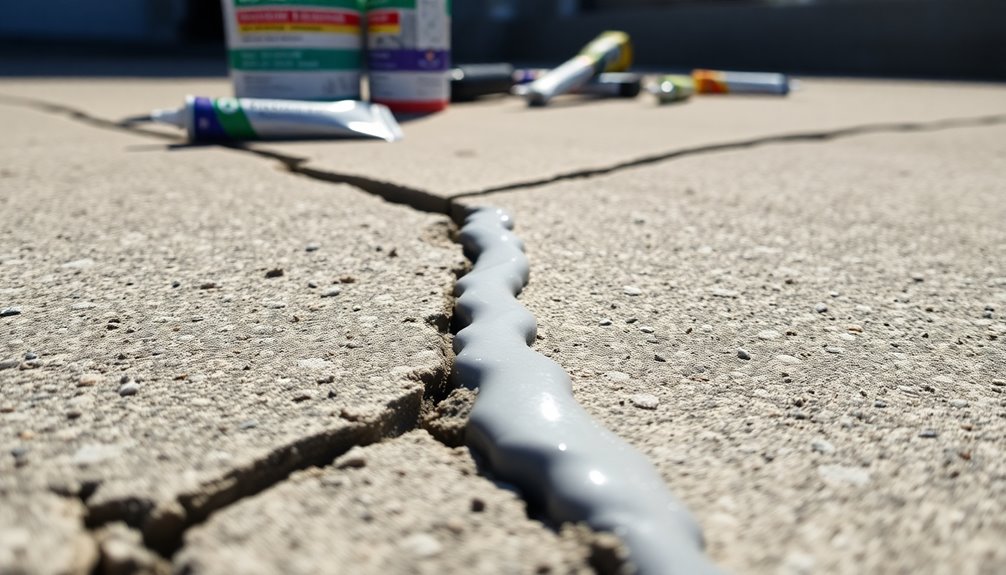
How do you choose the right crack filler for your driveway? Start by ensuring the filler matches your concrete type and can withstand your local weather conditions.
Check for chemical resistance and strong adhesion properties to guarantee a lasting bond. Look for a filler with the right viscosity, allowing it to flow into cracks without being too runny.
Consider the setting time and shrinkage to avoid future issues. Color matching is essential for a seamless finish, while low odor options improve indoor air quality.
Finally, assess the ease of application and clean-up requirements. Don't forget to compare costs, warranty options, and availability to find the best value for your needs.
Recommended Brands and Products
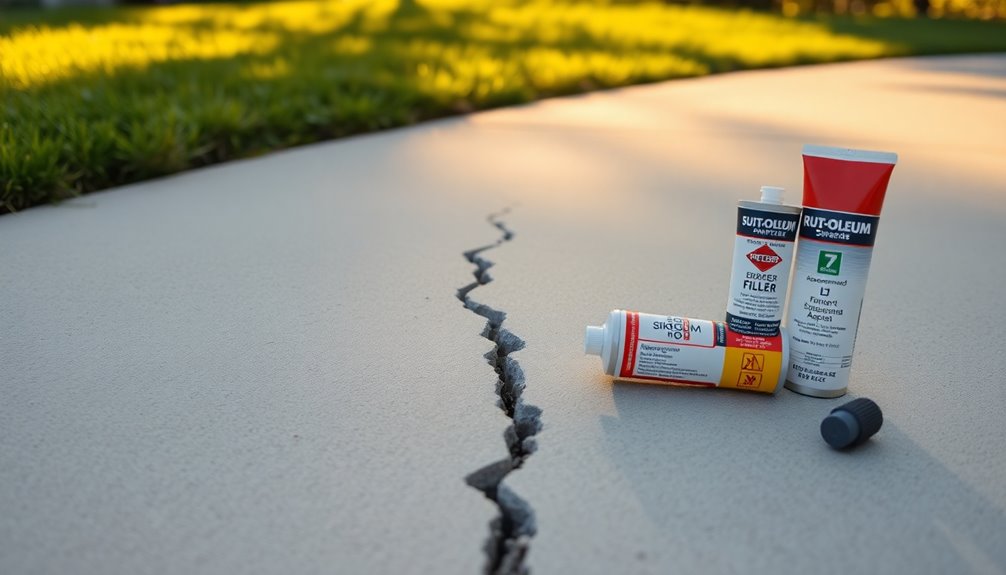
Selecting the right crack filler is just the first step; knowing which brands and products excel in performance is equally important.
For reliable options, consider Sika products like SikaFlex 290 for small cracks or SikaBond Epoxy for high-traffic areas.
Loctite also offers great choices, such as Loctite PL Premium for smaller gaps and Loctite Epoxy Instant Mix for quick fixes.
DAP's Concrete Patching Compound works well for medium cracks, while their Flex Seal is perfect for smaller joints.
Quikrete is another solid brand, with their Concrete Patching Compound and Flex Seal catering to various crack sizes.
Each of these brands provides effective solutions to help you repair your driveway like a pro.
Step-by-Step Application
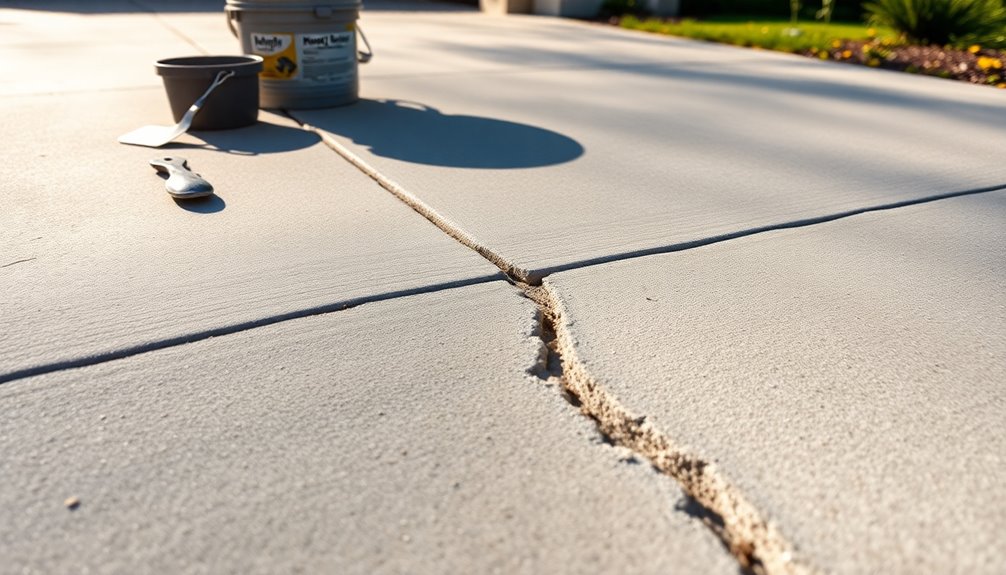
Before you start applying crack filler, it's essential to prepare the area properly to ensure a successful repair.
First, clean the driveway by removing debris and dirt. Make sure the surface is dry and free of moisture.
Next, scrape off any old filler or sealant, then inspect the cracks to assess their depth and width. Choose a filler that matches the size and type of cracks.
Now, apply the filler using a putty knife, then smooth it out with a trowel. Allow it to dry according to the manufacturer's instructions.
If needed, apply a second coat after the first has dried.
Finally, finish with a concrete sealant to protect the repaired area and ensure longevity.
Maintenance Best Practices
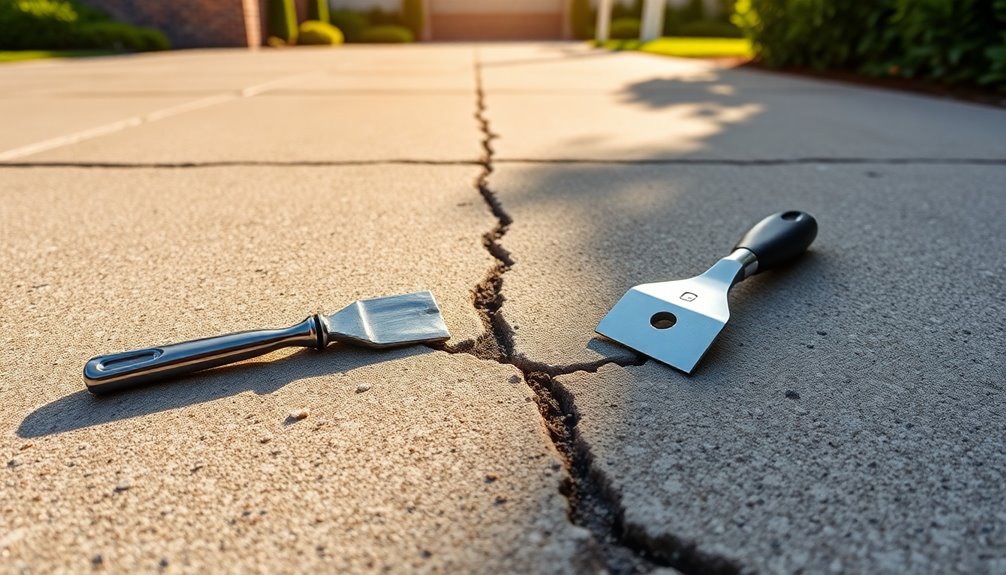
Maintaining your driveway is crucial to prolonging its lifespan and keeping it looking great. Start by inspecting it at least twice a year, checking for cracks, uneven surfaces, and water seepage. Use a flashlight, level, and measuring tape for accurate assessments, and document your findings.
Regularly clean your driveway with a broom or pressure washer, especially during winter, but avoid high pressure near cracks. Seal your driveway every 2-3 years on dry, sunny days to prevent water and salt damage.
Promptly repair small cracks using a concrete crack filler, and consider applying a driveway coating every 5-10 years to enhance appearance and durability. Consistent maintenance keeps your driveway in top shape!
Common Mistakes to Avoid

When it comes to filling cracks in your driveway, avoiding common mistakes can make all the difference in achieving a long-lasting repair.
First, ensure you select the right filler for your climate and concrete type; using the wrong one can lead to failure.
Prepare the crack by cleaning it thoroughly and removing any old filler properly.
Don't apply your filler too thickly or in uneven layers—thin layers dry better and adhere properly.
Allow adequate drying and curing time before exposing the area to traffic, and always check the weather conditions.
Lastly, follow the manufacturer's guidelines closely to avoid compatibility issues and ensure the best adhesion.
These steps will help you achieve a successful repair.
Cost Comparison of Fillers
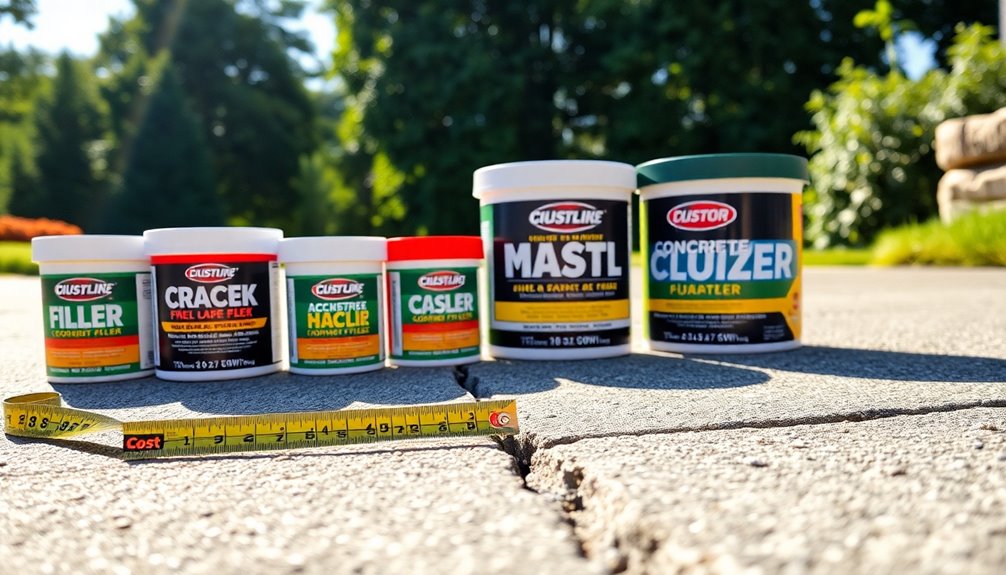
Choosing the right concrete crack filler for your driveway can significantly impact both your budget and the longevity of the repair.
Epoxy-based fillers cost between $50 to $150 per gallon, covering 100 to 200 square feet, and offer high durability.
Polyurethane fillers range from $30 to $100 per gallon, covering 150 to 300 square feet, and are resistant to water and UV light.
If you're looking for a budget option, acrylic fillers cost $20 to $70 per gallon and cover 200 to 400 square feet, though they're suitable for lighter traffic.
Cement-based fillers are the most affordable, priced at $10 to $40 per bag but cover only 10 to 20 square feet, making them suitable for minor cracks.
Enhancing Driveway Longevity
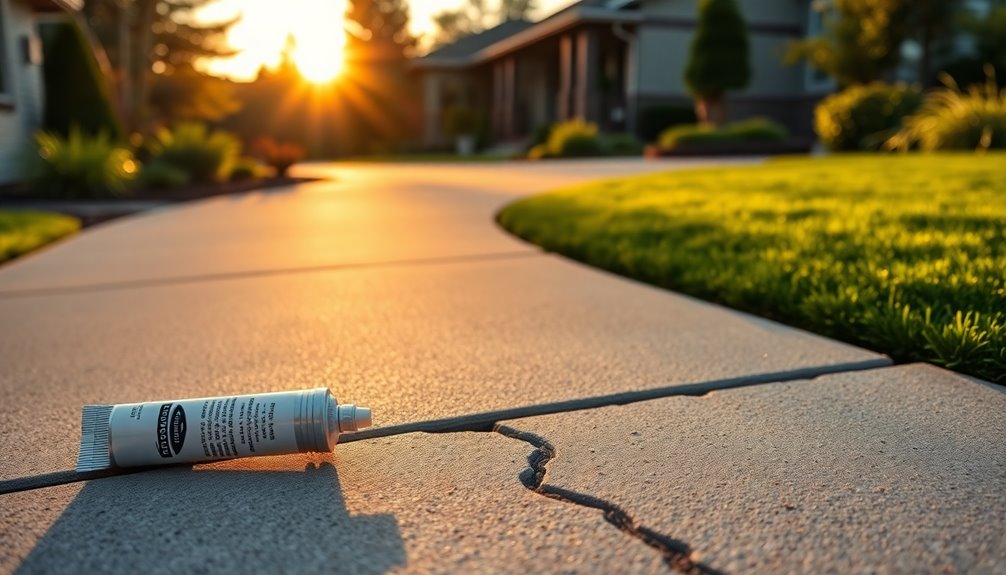
Investing in the right concrete crack filler is just the first step toward ensuring your driveway lasts for years. To enhance longevity, regularly inspect your driveway for cracks and clean the surface to prevent debris buildup. Seal any cracks promptly using a high-quality sealant that matches your driveway material, applying it seasonally for best results.
When filling cracks, clean the area thoroughly, use the correct filler, and apply it in thin layers to avoid bulging. Allow the filler to cure completely and compact it for better adherence.
Long-term care involves monitoring the filler's performance and reapplying sealant as needed. Keep your driveway clear of heavy loads and debris to maintain its integrity, and consider professional help for extensive damage.
Frequently Asked Questions
How Do I Know When to Fill a Crack?
You'll know it's time to fill a crack by assessing its size, location, and type. If the crack's less than 1/4 inch, it's usually safe to fill, while larger ones might need more attention.
Look for cracks in high-traffic areas or near drains, as they can worsen. Pay attention to seasonal changes, too. If cracks appear or grow during these times, it's best to address them promptly to prevent further damage.
Can I Use Filler in Freezing Temperatures?
You can use fillers in freezing temperatures, but it's crucial to choose the right type.
Epoxy-based fillers are often your best bet for cold weather due to their durability and resistance to temperature changes.
However, be aware that some fillers mightn't adhere well or could take longer to cure in the cold.
Always check the manufacturer's recommendations and ensure your concrete surface is clean and dry before application.
What Is the Lifespan of a Concrete Crack Filler?
The lifespan of a concrete crack filler can vary significantly based on several factors. It typically lasts 2-5 years, but high-quality options might stretch that to 7 years with proper care.
Weather conditions, traffic loads, and application methods all play a role. You'll want to regularly inspect and maintain the filler, as touch-ups can prevent larger issues down the line.
Are There DIY Options for Making Concrete Fillers?
Yes, there are several DIY options for making concrete fillers.
You can use epoxy-based fillers for long-lasting results, or go for polyurethane-based ones for quicker setting times.
Acrylic-based fillers are also effective and easier to mix.
If you prefer a more traditional approach, cement-based fillers work well too.
Just remember to clean the crack thoroughly before applying your chosen filler, ensuring a strong bond and durability.
Can I Paint Over the Filled Cracks?
Absolutely, you can paint over filled cracks! Just make sure the filled areas are completely dry and smooth.
Clean off any dust, then prime the surface for optimal adhesion. Choose a paint like epoxy for durability, and apply it evenly using a brush or roller.
Multiple thin coats work best, allowing each to dry fully. With the right preparation, your driveway will look as good as new—better even!
Conclusion
In a nutshell, choosing the right concrete crack filler can save you time and money down the road. By taking the right approach and avoiding common pitfalls, you'll fix your driveway like a pro. Remember, "a stitch in time saves nine," so don't wait for small cracks to turn into big problems. With the right products and techniques, you can enhance your driveway's longevity and keep it looking great for years to come!









